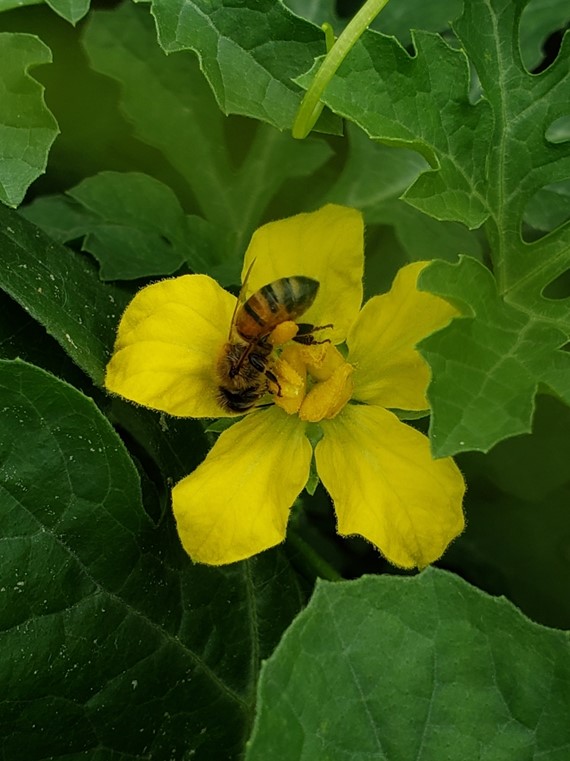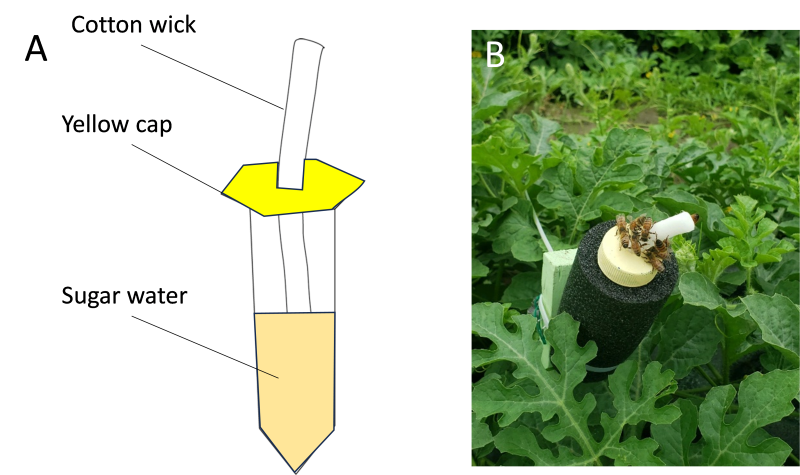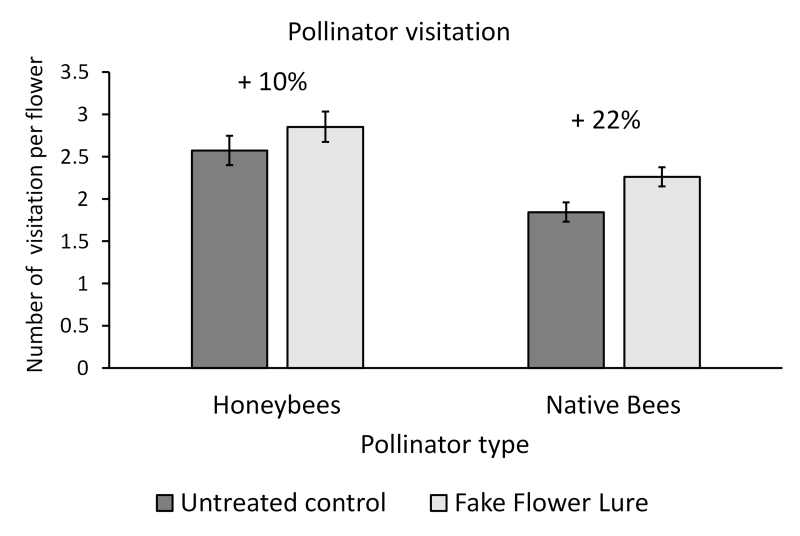Xavier Martini, UF/IFAS Horticulture Entomologist, Thomson Paris, Postdoctoral Associate, North Florida Research and Education Center, Quincy
Watermelon is a popular crop cultivated in the Suwanee Valley and the Florida Panhandle. One of the key aspects for watermelon production is to have optimal pollination. This is particularly important for seedless (triploid) watermelons, which are less attractive to pollinators and produce unviable pollen. Indeed, seedless watermelon are hybrids between diploid and a tetraploid watermelon, making them sterile. Consequently, seedless watermelons require pollen from a seeded (diploid) watermelon pollinizer flower that is interplanted among the seedless watermelons. The recommended ratio is three seedless transplants per every one seeded plant.

Figure 1: honeybee visiting a watermelon flower, with the three lobes of the stigma apparent. Credit Xavier Martini, UF/IFAS
A watermelon needs at least 1,000 grains of pollen evenly deposited on the three lobes of the stigma (Figure 1 right). An insufficient amount of pollen on one stigma lobe will result in an asymmetrical melon. For seedless watermelons, if bees do not adequately transfer diploid pollen, the female seedless flower will abort. In addition to an asymmetrical melon, insufficient pollination may also lead to hollow heart, which is characterized by a fruit with empty cavities where seeds would normally develop.
Honeybees, bumblebees, and native solitary bees are essential components of watermelon production. Approximately 8 bee visits are needed for seeded watermelons, whereas 16 to 24 visits are needed for triploid seedless watermelons. The time of bee visits is quite short, as flowers only open a couple of hours after sunrise (between 6 to 10:00 am) and usually close in the afternoon. Pollinator flights can be significantly reduced during rain events and when winds are above 15 mph. Unfortunately, we are also witnessing a decline in native bee populations, prompting growers to often add honeybee or bumblebee hives to their operation to enhance pollination. The estimated need for bee colonies varies from 1 to 5 colonies per acre.
To attract pollinators growers may need to resort to other methods for increasing honeybee visits to target flowers. The bee attractants (bee pheromone based) found on the commercial market have shown no effect on attracting bees or bumblebees and no increase in yield. Therefore, they are not recommended for use in watermelon. Cover crops can provide additional resources to pollinators. However, those cover crops should bloom slightly before watermelon to avoid competition with the main crop.
Last year, University of Florida researchers were awarded a grant from the National Watermelon Association. They experimented with a new technique to increase the pollination of seedless watermelons using an inexpensive, easy-to-build, fake flower lure. The lure comprised a container filled with sugary water, a yellow cap, and a long cotton wick (Figure 2 below). As the cotton absorbed the sugar water, it became available to the bees. The yellow cap acted as a visual cue to attract the bees. We observed a significant attraction of honeybees on the lures.

Figure 2: (A) schematic diagram of the fake flower lure, (B) aggregation of honeybees on the lure. Credit: Thomson Paris, UF/IFAS
–
We also noticed an increase in watermelon flower visitations when the lures were placed in proximity to the watermelon plot. We found that in the presence of the fake flower lures, the number of visits to watermelon flowers increased by 10% for honeybees and a significant 22% increase for native bees (Figure 3 below), resulting in a 20% increase in the number of fruits. While more research is needed to better understand the use this fake flower lure, this is an inexpensive tool that growers can use to increase pollination visitation of their crop flowers.

Figure 3: Pollinator visitations of watermelon flowers increased in the presence of fake flower lures.
–
More information on watermelon pollination is available by using the following publication link:
ENY-154/AA091: Beekeeping: Watermelon Pollination
- Pepper Weevil is a True Menace to Pepper Production - October 3, 2025
- Sap Beetles are Not a Cause of Concern for Citrus but Katydids Are - October 4, 2024
- The Importance of Pollination for Seedless Watermelons and How to Enhance it - April 5, 2024
